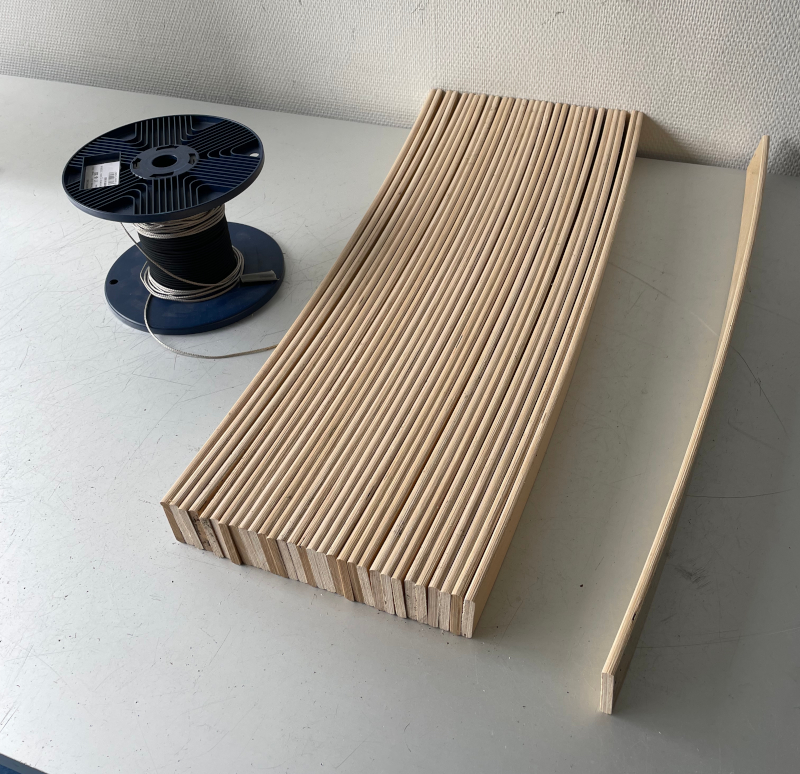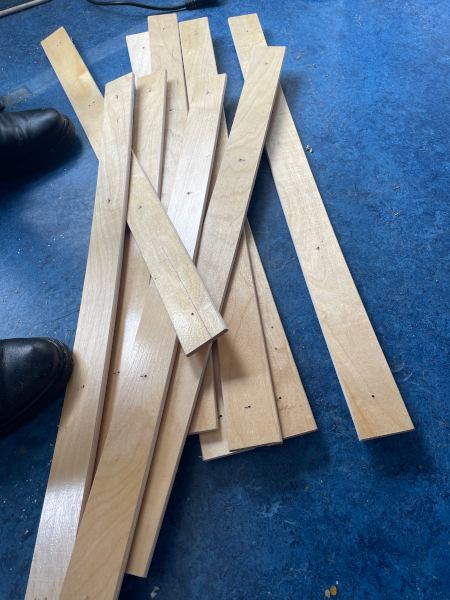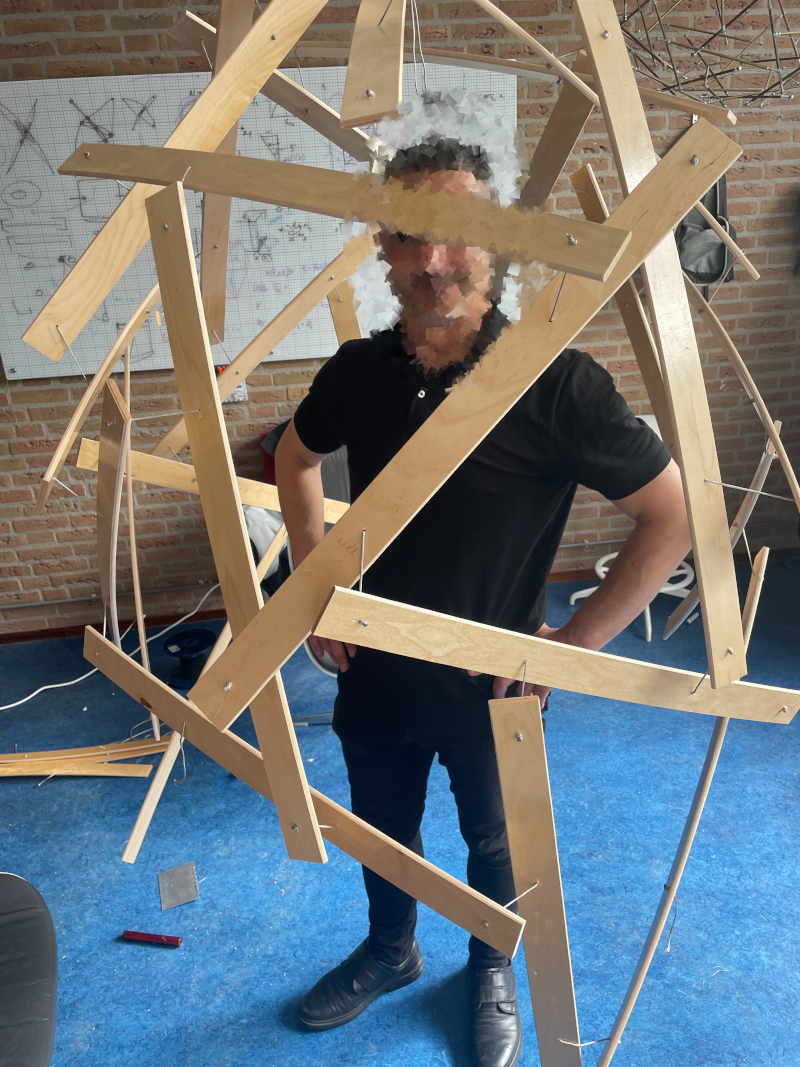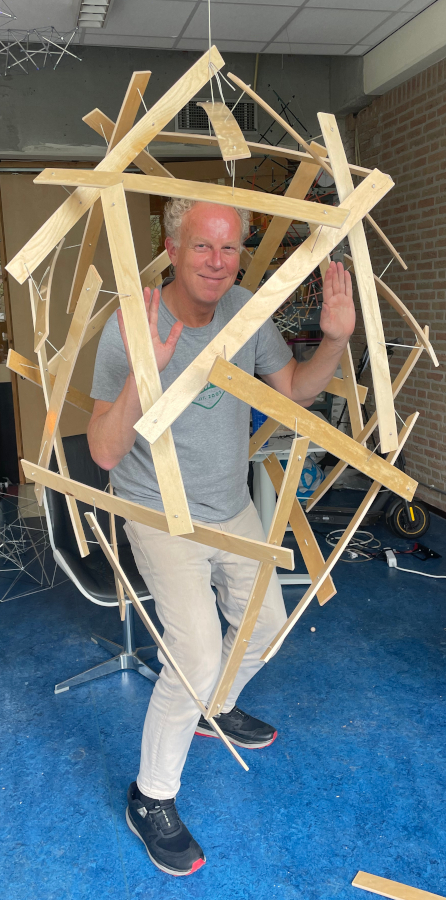PretensT
Tensegrity is a special kind of structure made of push and pull.
Project maintained by elastic-interval Hosted on GitHub Pages — Theme by mattgraham
Found a discarded bed
One day I was taking out the garbage bag to throw in the container on my street.
It was raining quite hard, but I didn’t have to walk far, so I expected to stay fairly dry.
Beside the garbage container someone had discarded a double bed with slats, like this one:

Normal people would probably continue with their day, but I couldn’t help but stand there and count the slats, because if there were thirty or more, I could make something out of them!
I was thinking of an interesting structure that I had once made from PVC pipe, which used the springiness of the curving pipes, rather than relying on the springiness of the cable. I suppose this is also a kind of tensegrity.

So yes, I ended up spending a long time in the rain getting soaked while demolishing the bed to collect those beautiful strong curved slats and taking them home.
Thirty Slats
After collecting and cleaning the slats (one to spare, just in case), I was ready to start figuring out how to use some Dyneema cord and turn the bed into a sphere!

Four holes equally spaced
The first thing to do is to drill four holes in each slat, and the holes have to be big enough to allow the cord to pass through, but not too big that they would fail to hold back a knot.

I was actually able to enlist the help of my Sicilian friend, so we were able to turn the process into a fairly efficient assembly line.

He was drilling holes into slat after slat, which is of course 120 holes in total, while I got busy cutting 60 cords of approximately the right length and stringing them through the holes.
Then I made a knot at one end of the all the cords and pulled them “upward” through the middle two holes of each slat.

Built hanging
Since this thing is going to end up as a sphere, it’s a lot easier to hang it and build downwards.
It was very nice to be able to do this with the help of my friend, because it was much easier with four hands than it would have been with two.

We had to quite forcefully pull the cords through holes which were almost exactly the width of the cord itself, and then tie a knot, and this all had to happen kind of hanging in midair.
The challenge of putting this together was fun, but as usual in the construction of tensegrity, it only really gets its shape when you make the final connections.

Final tightening
The first time that we had the whole sphere assembled it was quite loose and sagged considerably.
Obviously I had not estimated the length of the cords quite right, but this was not a problem.
All we had to do was pull each of the 60 cords a bit further out, make another knot below the existing one, and then let it go.
One extra knot everywhere and it was tight!

Conclusion
This is actually a very easy and gratifying project to do, if you ever find a discarded bed, because either it goes into the garbage, or it bounces like a ball:
Projects:
2024-07-23: "Bouncy Wooden Sphere": what you can do with a discarded bed2024-04-23: "Twisted Torque": tied into a permanent twist
2023-03-27: "Easy 30-Push Sphere": one simple element
2022-10-05: "Glass and LED": going big and colorful
2022-09-29: "Fascia": dancing with tensegrity
2022-08-30: "Mitosis": the four-three-two tensegrity
2022-08-04: "Push Bolts for the People": finalizing design and getting it out there
2022-06-22: "Head to Head Push Bolt": M5 and M6 bolts symbiosis
2022-05-30: "Hiding Knots": bump up the aesthetics
2022-05-25: "Innovation with 3D Printer": the push bolt
2021-12-02: "Headless Hug": breaking a rule for the sake of symmetry
2021-10-28: "Rebuilding the Halo": finally got it right
2021-10-20: "Convergence": growing and reconnecting
2021-07-27: "120-Strut Brass Bubble": taking the next step up in complexity
2021-05-26: "30-Strut Brass Bubble": bouncing spherical tensegrity
2021-04-08: "Bow Tie Tensegrity": better bend resistance
2021-03-29: "Six Twist Essential": what if more hands could see?!
2021-01-25: "Minimal Tensegrity": no more tension lines than absolutely necessary
2021-01-18: "Degrees of Freedom": first adjustable hybrid tensegrity
2021-01-11: "Fractal Experiment": a tensegrity of tensegrities
2020-12-09: "Axial Tension": pretensing what is already pretenst
2020-11-02: "Halo by Crane - Part 2": the strengthening
2020-10-26: "Halo by Crane - Part 1": assembly complete but strength lacking
2020-10-12: "Brass and Tulips": a tight and strong tensegrity tower
2020-08-10: "Prefab Tension Tower": the tower of eight twists
2020-07-27: "Elastic Bubble": building with elastic ease
2020-07-13: "The Twist Sisters": left-handed and right-handed
2020-07-06: "Radial Tension": Pulling towards the middle
2020-06-22: "Diamond of Tension": Four pulls for every push
2020-06-15: "Prefab Tension": Separating compression from tension